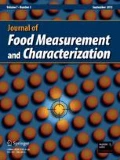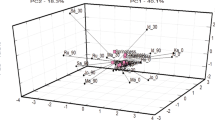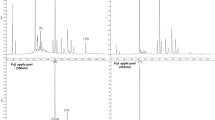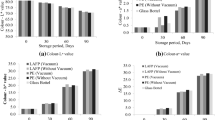Abstract
In this study, apples were damaged by dropping from different heights(40、60、80、100 and 120 cm) to the marble ground and stored at 1 °C and then the quality and dielectric parameters of the apples were measured after different storage durations (1、5、9、13、17、21 and 25 d). The results showed that the firmness, density, titratable acidity (TA), vitamin C and moisture content decreased, the browning degree and total soluble solid/titratable acidity(TSS/TA) increased, the total soluble solid (TSS) exhibited a increasing–decreasing trend with the storage time increased. The higher the drop height of the apples, the lower the firmness, density, TSS, TA, vitamin C and moisture content and the greater the browning degree and TSS/TA. A principal component analysis showed that two principle components could represent the dielectric parameters of the damaged fruit, and the accumulated variance contribution rate was more than 80%. At the characteristic frequency, which was selected using a gray correlation analysis, the principle components predicted the quality parameters and established the prediction models for quality parameters. The determination coefficients of prediction equation about density, TSS, TA, vitamin C and moisture content were all greater than 0.6, it was indicated that the prediction results of these quality parameters were better. The results are expected to provide a reference for the rapid evaluation of quality changes for damaged fruit by using electrical properties.

Similar content being viewed by others
References
F.J. García-Ramos, J. Ortiz-Cañavate, M. Ruiz-Altisent, Reduction of mechanical damage to apples in a packing line using mechanical devices. J Appl. Eng. Agric. 19(6), 703–707 (2003)
L. Lixin, W. Zhiwei, Dropping impact mechanical characteristics of apple. J. Trans. CSAE 23(2), 254–258 (2007). in Chinese
G. Elmasry, W. Ning, C. Vigneault et al., Early detection of apple bruises on different background colors using hyperspectral imaging. J. Swiss Soc. Food Sci. Technol. 41(2), 337–345 (2008)
S.N. Guerrero, S.M. Alzamora, P.L. Gomez et al., Relationships between rheological properties, texture and structure of apple (Granny Smith var.) affected by blanching and/or osmotic dehydration. J. Food Bioprocess Technol. 6(2), 475–488 (2013)
S. Cardenas-Perez, J. Chanona-Perez, J.V. Mendez-Mendez et al., Evaluation of the ripening stages of apple (Golden Delicious) by means of computer vision system. J. Biosyst. Eng. 159, 46–58 (2017)
P. Baranowski, W. Mazurek, J. Wozniak et al., Detection of early bruises in apples using hyperspectral data and thermal imaging. J. Food Eng. 110, 345–355 (2012)
D. Ballabio, V. Consonni, F. Costa, Relationships between apple texture and rheological parameters by means of multivariate analysis. Chemom. Intell. Lab. Syst. 111(1), 28–33 (2012)
M.M. Sofu, O. Er, M.C. Kayacan et al., Design of an automatic apple sorting system using machine vision. J. Comp. Electron. Agric. 127, 395–405 (2016)
K. Fanrong, G. Wenchuan, Relationship between dielectric properties and physicochemical properties of apples during late developmental period. Food Sci. 37(09), 13–17 (2016). in Chinese
A. Bhosale, K.K. Sundaram, Firmness prediction of the apple using capacitance measurement. J. Proc. Echnol. 12, 163–167 (2014)
M.V. Traffano-schiffo, M. Castro-giraldez, R.J. Colom et al., New spectrophotometric system to segregate tissues in mandarin fruit. J. Food Bioprocess Technol. 11, 399–406 (2018)
R. Alimardani, M. Omid, M. Soltani, Evaluating banana ripening status from measuring dielectric properties. J. Food Eng. 105(4), 625–631 (2011)
M. Soltani, R. Alimardani, M. Omid, Evaluating banana ripening status from measuring dielectric properties. J. Food Eng. 105(4), 625–631 (2011)
R. Zywica, J.K. Banach, Simple linear correlation between concentration and electrical properties of apple juice. J. Food Eng. 158, 8–12 (2015)
S. Wang, M. Monzon, Y. Gazit et al., Temperature dependent dielectric properties of selected subtropical and tropical fruits and associated insect pests. J. Trans. ASAE 48(5), 1873–1881 (2005)
W.C. Guo, S.O. Nelson, S. Trabelsi, S.J. Kays, 10–1800MHz dielectric properties of fresh apples during storage. J. Food Eng. 83(4), 562–569 (2007)
N. Lanchun, S. Jianshe, X. Bei et al., Study on enzymatic browning substrate and polyphenol oxidase activity of apple fruits. J. Hortic. 31(4), 502–504 (2004). (in Chinese)
Ministry of Agriculture, Evaluation specification for quality indexes of apple: NY/T: 2316-2013[S] (China Standard Press, Beijing, 2013), p. 8. (in Chinese)
General Administration of Quality Supervision, Inspection and Quarantine. Determination of total acid in foods: GB/T 12456–2008[S] (China Standard Press, Beijing, 2008), pp. 1–5. (in Chinese)
National Health and Family Planning Commission, National standards for food safety—determination of ascorbic acid in food: GB 5009.86-2016[S] (China Standard Press, Beijing, 2016), pp. 7–8. (in Chinese)
National Health and Family Planning Commission, National standards for food safety—determination of moisture content in food: GB 5009.3-2016[S] (China Standard Press, Beijing, 2016). (in Chinese)
H. Bian, P. Tu, X. Zhang, Dielectric properties of different grades of Lilium davidiivar unicolor. J Food science 34(3), 105–108 (2013). (in Chinese)
R. Battiti, Using mutual information for selecting features in supervised neural net learning. J. IEEE Trans. Neural Netw. 5(4), 537–550 (1994)
M.C. Bourne, Effect of blanch temperature on kinetics of thermal softening of carrots and green beans. J. Food Sci. 52(3), 667–668 (1987)
D.W. Stanley, M.C. Bourne, A.P. Stone et al., Low temperature blanching effects on chemistry, firmness and structure of canned green beans and carrots. J. Food Sci. 60(2), 327–333 (1995)
W. Sen, X. Bixia, Study on browning mechanism and anti-browning technology of pear flesh. Northern Fruits 05, 4–7 (2004). (in Chinese)
R. Shrama, D.R. Rai, S.N. Jha, Physico-chemical quality parameters and overall quality index of apple during storage. J. Food Sci. Technol. 49(5), 594–600 (2012)
H.S. Burdurlu, N. Koca, F. Karadeniz, Degradation of vitamin C in citrus juice concentrates during storage. J. Food Eng. 74(2), 211–216 (2006)
R.B.H. Wills, K.J. Scott, Effect of water loss from apples during cool storage on the water content of the fruit. J. Sci Food Agric. 23(9), 1135–1136 (1972)
M.E. Martín-Esparza, N. Martínez-Navarrete, A. Chiralt, P. Fito, Dielectric behavior of apple (var. Granny smith) at different moisture contents Effect of vacuum impregnation. J. Food Eng. 77(1), 51–56 (2005)
S. Jiangjie, H. Sen, Z. Yuanmin, Study on the electricity characteristic research of postharvest starkrimson. J North Garden 06, 9–11 (2011). (in Chinese)
H. Bian, P. Tu, X. Hua-li, P. Shi, Quality predictions for bruised apples based on dielectric properties. J. Food Process. Preserv. 43, e14006 (2019)
F.R. Harker, H.J. Elgar, C.B. Watkins, Physical and mechanical changes in strawberry fruit after high carbondioxide treatments. J. Postharvest Biol. Technol. 19(2), 139–146 (2000)
J. Ahmed, H.S. Ramaswamy, G.S.V. Raghavan, Dielectric properties of indian basmati rice flour slurry. J. Food Eng. 80(4), 1125–1133 (2007)
Acknowledgements
This work was funded by the Natural Science Foundation of China (Grant No. 31560474) and Science and Technology Innovation Funds of Gansu Agricultural University—Special Funds for Discipline Construction (GAU-XKJS-2018-134).
Author information
Authors and Affiliations
Corresponding author
Additional information
Publisher's Note
Springer Nature remains neutral with regard to jurisdictional claims in published maps and institutional affiliations.
Rights and permissions
About this article
Cite this article
Bian, H., Shi, P. & Tu, P. Determination of physicochemical quality of bruised apple using dielectric properties. Food Measure 14, 2590–2599 (2020). https://doi.org/10.1007/s11694-020-00505-1
Received:
Accepted:
Published:
Issue Date:
DOI: https://doi.org/10.1007/s11694-020-00505-1




